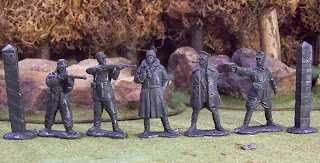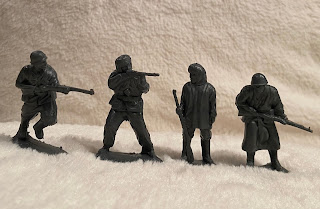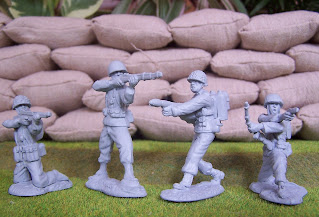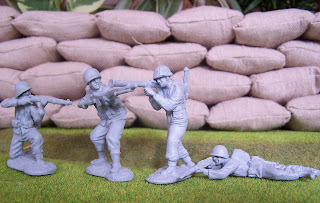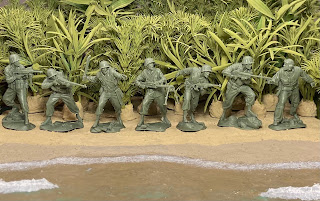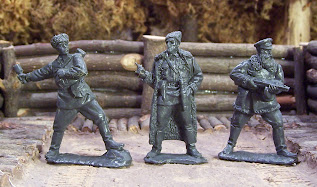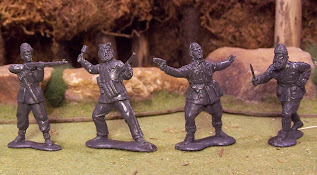WW23d.com is an online outlet that specializes in the 3D printing of -you guessed it- WW2 figures. They cover the main participants: US, Soviet Union, Great Britain, Germany and Japan. They are a recent arrival on the toy soldier scene. I am not 100% sure when they got started, but I ran into them during the summer of 2023 through a Facebook page called WW23D prints. I don't think they author the designs of the figures, but rather partner with others who upload their designs into their site. One thing that is a very nice touch when you buy from them is that you get a letter along with your figures. The letter contains the orders for a 'mission' that your men have been assigned. The mission corresponds to some actual engagement in which that service branch actually fought. I believe that they specialize on 1/32 scale. Unfortunately I just visited their web site only to discover that it is 'temporarily closed'. You can't even browse their catalog. I hope they are not out of business, as they were a good alternative to Speira Miniatures which also sells 3D printed soldiers, but at about double the price. And if I recall correctly some of the designs are available on both sites. Luckily I ordered a good batch of figures while they were still open, so let's take a look at what I managed to get my hands on.
Dedicated to exploring the world of Plastic Toy Soldiers. The focus is WWII figures & vehicles in 1:32 (54mm), although there's also a bit of Vietnam. If you grew up playing with them or simply love to collect them, this is the place for you. The posts are organized by Manufacturer & by Country/Service branch. Use the menu of labels on the right side of the blog to find what interests you. Comments are welcome. Please note that this site uses Google Analytics & AdSense cookies.
Google Analytics
Auto Ads
Search This Blog
Monday, December 25, 2023
WW23D.com Toy Soldiers
Saturday, July 22, 2023
Introducing the Finnish Infantry
This peace lasted until the beginning of Operation Barbarossa, when the Germans attacked the Soviet Union. Finland, allied with Germany, began its military operations which became known as the Continuation War. During this campaign, Finland was able to recover their lost territories and to its credit, halted at its original border, rendering this sector of the front relatively quiet, even while Germany pressed on the attack and lay siege to Leningrad for 28 months. Finnish actions were limited to repulsing the occasional Soviet attack, although the Soviets did attempt to wage an air bombing campaign against Helsinki, which had very limited impact. In the summer of '44, 3 days after the Normandy landings, The Soviet Union launched a major offensive along the Karelian Isthmus. In about a month, they pushed the Finnish back close to 100km, roughly to the border established at the end of the Winter War. It was thanks to German support in the form of men and materiel that the Finns were able to stop the Soviet advance. However, this made them determined to negotiate a separate peace, while they still had a 'stable' front and before Germany collapsed. A peace agreement was reached in September of '44, with Finland agreeing to pay 600M in reparations.
The last phase of the war became known as the Lapland War and consisted mainly of chasing the Germans out of Finland, as agreed to by the peace terms with the Soviet Union, even as the Finnish Army was being demobilized, also per the terms of the peace agreement. This campaign was relatively peaceful, as both sides did not want to fight each other, and consisted mainly of isolated rearguard actions as the Germans moved out of Finland into Norway. The Germans did leave behind considerable destruction in their wake as they burned out buildings which the pursuing Finns might be able to use for shelter, and they also destroyed bridges and mined roads, causing further casualties for years to come. Casualties from these campaigns totaled 26k dead or missing out of 340k during the Winter War,63k dead or missing out of 530k during the Continuation War, and a little over 1k out of 75k during the Lapland War. In terms of Toy Soldiers, this is a theater that has not really been covered by solider manufacturers and it wasn't until recently that one set became known to me. Let's take a look.
Friday, July 21, 2023
Introducing the US Marines
Tuesday, July 18, 2023
Introducing the German Don Cossacks
Monday, July 17, 2023
Introducing the German Panzer Crews
The German Panzerwaffe or Panzertruppe were the men responsible for operating the armored vehicles such as tanks and self-propelled anti-tank guns within the German armed forces. They were known for their black uniforms, and tight fitting, double-breasted jackets, inspired by the uniforms of former Hussars. This makes sense, considering that they were the armored evolution of the cavalry. Their piping color was pink and their insignia in caps and collars included skulls / Totenkopf which is something that they earlier Brunswick Hussars also wore, but which became problematic for the Panzertruppen particularly towards the end of the war when many of them would get shot on the spot upon capture after being mistaken for death camp guards. Within the command of the Panzerwaffe, and attached to the armored units, there were also Panzergrenadier which could be transported in half-tracked armored vehicles, or in trucks. Panzer crews would typically remain within their vehicles, as that's the way in which they could be the most lethal. It was the Panzergrenadiers, who were much better trained in infantry tactics, which were responsible for complementing the tanks offensively or defensively. The ratio of half-tracks to trucks available to transport the Panzergrenadiers would depend on the elite status of the division. Divisions such as the Panzer Lehr, raised from skilled, decorated veterans who had been transferred to the two main training schools for motorized troops, received many more armored vehicles. It was also within some of these divisions such as the Panzer Lehr, that also the Panzergrenadier wore the double-breasted jacket as their uniform, albeit in grey fabric. In terms of toy soldiers, Panzer crews have been released along with their vehicles by firms such as Forces of Valor or 21st Century Toys, however the poses are usually that of a commander standing at the turret or a driver/machine gunner taking a peek out of the front hatches. Up to now, nobody had manufactured dismounted Panzertruppen. But that changed recently. Let's take a look.
Friday, July 14, 2023
Introducing the Soviet NKVD
The Soviet NKVD was the organization within the Soviet Union responsible for protecting the state and its political ideology from internal threats. It was a mix of an intelligence agency and secret police. They were also in charge of guarding the borders as well as the prison camps. Its origins go back to the Revolution of 1917. In the years preceding WW2, they conducted a series of ruthless campaigns and purges against the Soviet people. Some of them politically motivated, but sometimes also ethnically-driven. And sometimes simply quota-driven against a certain region or occupational group, such as the clergy or army officers, as was the case during the great purge of 1937. Many others were arrested and sent to prison camps or gulags where they languished or were executed. Most of these arrests and trials were performed with minimum evidence, often just the word of someone who declared someone else an 'enemy of the people', and confessions were obtained through brutal methods. They were also responsible for the execution of 22,000 captured Polish officers in what became known as the Katyn massacre when Germany and the Soviet Union invaded and split Poland at the start of the war. The actual NKVD was formed shortly after Germany invaded the Soviet Union in the summer of 1941. Their role expanded to ensure that the Soviet Army fought as expected and in order to 'increase morale', NKVD units often shot at Soviet troops attempting to retreat. If you have not watched the movie Enemy at the Gates, this is well illustrated in this film, when the NKVD men unleash a storm of machine gun fire at some retreating Soviet conscripts who have no chance of succeeding in a frontal attack at Stalingrad. The NKVD formed multiple divisions during the war, and while most were used for the stated purposes, a few of them were also used as frontline troops as was the case in Stalingrad and Crimea. As the tides of war changed, the NKVD was either involved in sabotage activities behind German lines, or was busy clearing the liberated territories from collaborators and Nazi sympathizers. By the end of the war, the NKVD ranks numbered over 1.5 million men. The Soviet Union created a similar organization, which actually splintered off the NKVD, to guard against foreign spies and bad influences within the Red Army. That organization was called SMERSH. It is so similar in nature that one could easily confuse them. Anyhow, the NKVD was definitely a controversial organization. Perhaps it is due to this, or to its limited combat role, that NKVD troops had not been represented in the Plastic Toy Soldier hobby until recently, when Hanomak introduced its set. Let's take a look.













